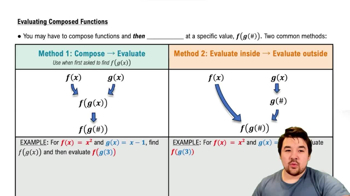Table of contents
- 0. Functions7h 52m
- Introduction to Functions16m
- Piecewise Functions10m
- Properties of Functions9m
- Common Functions1h 8m
- Transformations5m
- Combining Functions27m
- Exponent rules32m
- Exponential Functions28m
- Logarithmic Functions24m
- Properties of Logarithms34m
- Exponential & Logarithmic Equations35m
- Introduction to Trigonometric Functions38m
- Graphs of Trigonometric Functions44m
- Trigonometric Identities47m
- Inverse Trigonometric Functions48m
- 1. Limits and Continuity2h 2m
- 2. Intro to Derivatives1h 33m
- 3. Techniques of Differentiation3h 18m
- 4. Applications of Derivatives2h 38m
- 5. Graphical Applications of Derivatives6h 2m
- 6. Derivatives of Inverse, Exponential, & Logarithmic Functions2h 37m
- 7. Antiderivatives & Indefinite Integrals1h 26m
- 8. Definite Integrals4h 44m
- 9. Graphical Applications of Integrals2h 27m
- 10. Physics Applications of Integrals 2h 22m
3. Techniques of Differentiation
The Chain Rule
Problem 84d
Textbook Question
Use the given graphs of f and g to find each derivative. <IMAGE>
d/dx (f(f(x))) |x=4
 Verified step by step guidance
Verified step by step guidance1
Step 1: Understand the problem requires finding the derivative of a composite function, specifically f(f(x)), at x = 4.
Step 2: Apply the chain rule for derivatives, which states that the derivative of a composite function f(g(x)) is f'(g(x)) * g'(x).
Step 3: Identify the inner function g(x) as f(x) and the outer function f(g(x)) as f(f(x)).
Step 4: Evaluate the derivative of the outer function f'(f(x)) and the derivative of the inner function f'(x) at x = 4 using the given graphs.
Step 5: Multiply the derivatives from Step 4 according to the chain rule: f'(f(4)) * f'(4).
 Verified video answer for a similar problem:
Verified video answer for a similar problem:This video solution was recommended by our tutors as helpful for the problem above
Video duration:
5mPlay a video:
Was this helpful?
Key Concepts
Here are the essential concepts you must grasp in order to answer the question correctly.
Chain Rule
The Chain Rule is a fundamental principle in calculus used to differentiate composite functions. It states that if you have a function f(g(x)), the derivative is f'(g(x)) * g'(x). This rule is essential for finding the derivative of functions where one function is nested inside another, as in the case of f(f(x)).
Recommended video:

Intro to the Chain Rule
Derivative
A derivative represents the rate of change of a function with respect to its variable. It is a measure of how a function's output value changes as its input value changes. Understanding how to compute derivatives is crucial for analyzing the behavior of functions, including finding slopes of tangent lines and optimizing functions.
Recommended video:

Derivatives
Evaluating Functions
Evaluating functions involves substituting specific values into a function to determine its output. In this context, after finding the derivative of f(f(x)), you will need to evaluate it at x=4. This step is important for obtaining a numerical result that reflects the behavior of the composite function at that particular point.
Recommended video:

Evaluating Composed Functions

 5:02m
5:02mWatch next
Master Intro to the Chain Rule with a bite sized video explanation from Callie
Start learningRelated Videos
Related Practice






